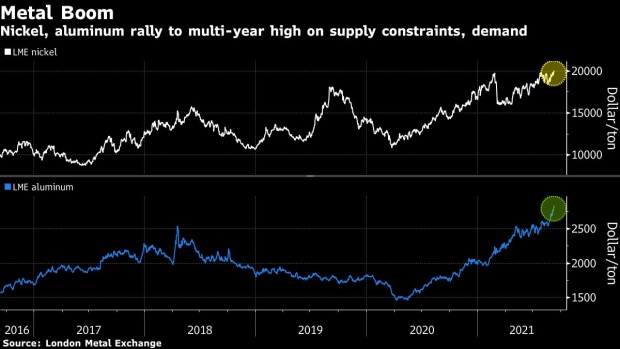Sep 9, 2021
Industrial Metals Charge to Fresh Highs as Inflation Runs Hot
, Bloomberg News

(Bloomberg) -- A broad rally in base metals markets is gathering pace, with tight supply, logistical logjams and booming demand creating an inflationary storm that’s driving prices to multiyear highs.
Aluminum notched a fresh 13-year high and nickel rose to the highest since 2014 in London. Both metals are benefiting from China’s crackdown on emissions from energy-intensive industries, while their role in the green revolution is buoying the longer-term outlook.
The surge in commodities, as well as soaring shipping and power costs, is fueling global consumer prices. China’s factory-gate inflation accelerated to a 13-year high, while U.S. consumer prices are forecast to rise by more than 5% for a third straight month. That could push Chinese policymakers to redouble their efforts to quench surging prices after moves to curb speculation in commodities futures and sell state reserves yielded mixed results.
“China’s interventions have had varied effects in the metals markets, and copper has certainly moved lower since it started selling state reserves,” Xiao Fu, head of commodities research at BOCI Global Commodities Ltd, said by phone from London. “Speculative positions have been trending lower in copper, and interest has shifted into other markets, with aluminum probably being the top pick at present.”
The rally in metals echoes the wider boom this year across the commodities and energy complex. Natural gas prices are undergoing a historic surge and thermal coal futures in China rose above 1,000 yuan ($155) a ton for the first time on Thursday.
There are already signs that the commodities boom is reshaping consumption patterns. Top air-conditioner maker, Japan’s Daikin Industries Ltd., plans to replace half of the copper in its units with aluminum by 2025. And a Chinese state researcher is working with top home-appliances groups on using more aluminum.
What BloombergNEF Says
“Metals production accounted for over 20% of China’s carbon emissions in 2020, according to BloombergNEF. As the country aims to achieve net zero emissions by 2060, industrial metals production is being realigned with its long-term decarbonization plans.”
--Nilushi Karunaratne. Click here for the research
Still, with aluminum prices surging 43% this year, the lightweight metal’s cost-competitiveness against copper is fading fast. That highlights the challenges for consumers looking at substitution as a way to insulate themselves from the synchronized surge in industrial metals and broader commodities markets.
Read more: China Will Need to Reassess Its Efforts to Cap Commodity Prices
Aluminum climbed as much as 1.9% to $2,848 a ton on the London Metal Exchange, the highest since 2008, before settling at $2,839.50 at 5:51 p.m. local time. As well as production constraints in China, the metal has been given an additional boost from concerns a coup in Guinea may tighten the supply of bauxite, the key raw material used to make aluminum. Nickel jumped as much as 2.9% to $20,280 a ton. All other main LME metals advanced.
Nickel, a key component in electric-vehicle batteries, is expected to be among the raw materials that stand to gain most from a global transition to low-carbon energy sources. Tesla Inc. in July struck a nickel-supply deal with BHP Group as the EV maker seeks to protect itself from a future supply crunch.
In the meantime, surging Chinese production of stainless steel is fueling nickel demand. Stainless futures rose as much as 2.7%, while steel rebar climbed more than 4%.
©2021 Bloomberg L.P.


